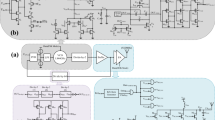Abstract
This paper presents a wideband frequency-shift keying (FSK) demodulator suitable for a digital data transmission chain of wireless neural stimulation microsystems such as cochlear implants and retinal prostheses. The demodulator circuit derives a constant frequency clock directly from an FSK carrier, and uses this clock to sample the data bits. The circuit occupies 0.03 mm2 using a 0.6 μm, 2M/2P, standard CMOS process, and consumes 0.25 mW at 5 V. This circuit was experimentally tested at transmission speed of up to 2.5 Mbps while receiving a 5∼10 MHz FSK carrier signal in a cochlear implant system.
Similar content being viewed by others
References
Dong, M., Zhang, C., Wang, Z.H., Li, D.M., 2004. A Neuro-Stimulus Chip with Telemetry Unit for Cochlear Implant. Proc. 2004 IEEE International Workshop on Biomedical Circuits and Systems, ppS1.3.INV-9. Singapore.
Galbraith, D., Soma, M., White, R., 1987. A wide-band efficient inductive transdermal power and data link with coupling insensitive gain. IEEE Trans. Biomed. Eng., 34:265–275.
Ghovanloo, M., 2004. A wideband frequency-shift keying wireless link for inductively powered biomedical implants. IEEE Trans. Circuits & Systems—I: Regular Papers, 51(12):2374–2383. [doi:10.1109/TCSI.2004.838144]
Heetderks, W., 1988. RF powering of millimiter-and submillimeter-sized neural prosthetic implants. IEEE Trans. Biomed. Eng., 35(5):323–327. [doi:10.1109/10.1388]
Ko, W.H., Liang, S.P., Fung, C.D., 1977. Design of radio-frequency powered coils for implant instruments. Med. Bio. Eng. Comput., 15:634–640.
Lin, J., 1986. Computer Methods for Field Intensity Predictions. In: Polk, C., Postow, E. (Eds.), CRC Handbook of Biological Effects of Electromagnetic Fields. CRC Press, Boca Raton, FL, p.273–313.
Liu, W., Vichienchom, K., Clements, M., DeMarco, S.C., Hughes, C., McGucken, E., Humayun, M.S., De Juan, E., Weiland, J.D., Greenberg, R., 2000. A neuro-stimulus chip with telemetry unit for retinal prosthetic device. IEEE J. Solid-State Circuits, 35(10):1487–1497. [doi:10.1109/4.871327]
McDermott, H., 1989. An advanced multiple channel cochlear implant. IEEE Trans. Biomed. Eng., 36(7):789–797. [doi:10.1109/10.32112]
Rauschecker, J., Shannon, R., 2002. Sending sound to the brain. Science, 295(5557):1025–1029. [doi:10.1126/science.1067796]
Suaning, G., Lovell, N., 2001. CMOS neuro-stimulation ASIC with 100 channels, scalable output, and bidirectional radio-frequency. telemetry. IEEE Trans. Biomed. Eng., 48(2):248–260. [doi:10.1109/10.909646]
Troyk, P., 2001. Development of BION Technology for Functional Electrical Stimulation: Bidirectional Telemetry. Proc. 23rd IEEE-EMBS Conf., 2:1317–1320.
Zhang, L., Wang, Z.H., Li, Y.M., Zhang, C., Wang, Z.H., Chen, H.Y., 2005. Clock generator and OOK modulator for RFID application. Journal of Zhejiang Univ. Sci., 6A(10):1051–1054. [doi:10.1631/jzus.2005.A1051]
Zierhofer, C., Hochmair, E., 1990. High-efficiency coupling-insensitive transcutaneous power and data transmission via an inductive link. IEEE Trans. Biomed. Eng., 37(7):716–722. [doi:10.1109/10.55682]
Zierhofer, C., Hochmair, E., 1996. Geometric approach for coupling enhancement of magnetically coupled coils. IEEE Trans. Biomed. Eng., 43(7):708–714. [doi:10.1109/10.503178]
Zierhofer, C., Hochmair-Desoyer, I., Hochmair, E., 1995. Electronic design of a cochlear implant for multichannel high-rate pulsatile stimulation strategies. IEEE Trans. on Rehab. Eng., 3(1):112–116. [doi:10.1109/86.372900]
Zrenner, E., 2002. Will retinal implants restore vision? Science, 295(5557):1022–1025. [doi:10.1126/science.1067996]
Author information
Authors and Affiliations
Additional information
Project supported by the National Basic Research Program (973) of China (No. G2000036508) and the National Natural Science Foundation of China (No. 60475018)
Rights and permissions
About this article
Cite this article
Dong, M., Zhang, C., Mai, Sp. et al. A wideband frequency-shift keying demodulator for wireless neural stimulation microsystems. J. Zhejiang Univ. - Sci. A 7, 1056–1060 (2006). https://doi.org/10.1631/jzus.2006.A1056
Received:
Accepted:
Published:
Issue Date:
DOI: https://doi.org/10.1631/jzus.2006.A1056




